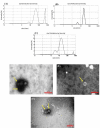Polyethylene Glycol -Mediated Exosome Isolation: A Method for Exosomal RNA Analysis
- PMID: 38468372
- PMCID: PMC11186611
- DOI: 10.61186/ibj.4129
Polyethylene Glycol -Mediated Exosome Isolation: A Method for Exosomal RNA Analysis
Abstract
Background: : Exosomal RNAs (ExoRNAs) offer valuable insights into their cellular origin. ExoRNA studies were faced with challenges in obtaining sufficient amounts of high-quality RNA. Herein, we aimed to compare three traditional exosome isolation methods to introduce an appropriate strategy to extract RNA from cancer-derived exosomes for further RNA analysis.
Methods: Exosomes were isolated through ultracentrifugation, precipitation kit, and size exclusion column chromatography, and then characterized by dynamic light scattering and transmission electron microscopy, followed by extracting total RNA. The quality and quantity of the extracted RNAs were assessed by a NanoDrop and 2.5% agarose gel electrophoresis.
Results: Extracted exosomes displayed a similar range of size and morphology. We found that polyethylene glycol-precipitation method resulted in a higher RNA yield with a 260/280 ratio of 1.9. The obtained exoRNA appeared as a smear in the agarose gel, indicative of small exoRNAs.
Conclusion: We provide researchers a suitable approach to isolate exosomes based on yield and purity of exoRNA.
Keywords: Exosomes; Extracellular vesicles; MicroRNA.
Conflict of interest statement
The authors declare that they have no competing interests.
Figures



Similar articles
-
Comparison of isolation methods of exosomes and exosomal RNA from cell culture medium and serum.Int J Mol Med. 2017 Sep;40(3):834-844. doi: 10.3892/ijmm.2017.3080. Epub 2017 Jul 24. Int J Mol Med. 2017. PMID: 28737826 Free PMC article.
-
Tandem enrichment of serum exosomes and exosomal RNA with titanium dioxide.J Chromatogr A. 2023 Mar 29;1693:463882. doi: 10.1016/j.chroma.2023.463882. Epub 2023 Feb 21. J Chromatogr A. 2023. PMID: 36857982
-
Comparison of morphology, protein concentration, and size distribution of bone marrow and Wharton's jelly-derived mesenchymal stem cells exosomes isolated by ultracentrifugation and polymer-based precipitation techniques.Tissue Cell. 2024 Jun;88:102427. doi: 10.1016/j.tice.2024.102427. Epub 2024 May 31. Tissue Cell. 2024. PMID: 38833940
-
The potential of circulating exosomal RNA biomarkers in cancer.Expert Rev Mol Diagn. 2020 Jul;20(7):665-678. doi: 10.1080/14737159.2020.1745064. Epub 2020 Apr 2. Expert Rev Mol Diagn. 2020. PMID: 32188269 Review.
-
Exosome isolation based on polyethylene glycol (PEG): a review.Mol Cell Biochem. 2025 May;480(5):2847-2861. doi: 10.1007/s11010-024-05191-x. Epub 2024 Dec 19. Mol Cell Biochem. 2025. PMID: 39702782 Review.
References
MeSH terms
LinkOut - more resources
Full Text Sources
